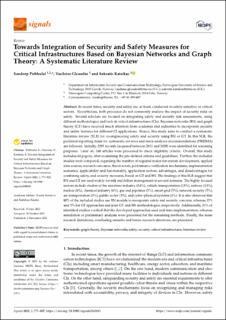| dc.description.abstract | In recent times, security and safety are, at least, conducted in safety-sensitive or critical sectors. Nevertheless, both processes do not commonly analyze the impact of security risks on safety. Several scholars are focused on integrating safety and security risk assessments, using different methodologies and tools in critical infrastructures (CIs). Bayesian networks (BN) and graph theory (GT) have received much attention from academia and industries to incorporate security and safety features for different CI applications. Hence, this study aims to conduct a systematic literature review (SLR) for co-engineering safety and security using BN or GT. In this SLR, the preferred reporting items for systematic reviews and meta-analyses recommendations (PRISMA) are followed. Initially, 2295 records (acquired between 2011 and 2020) were identified for screening purposes. Later on, 240 articles were processed to check eligibility criteria. Overall, this study includes 64 papers, after examining the pre-defined criteria and guidelines. Further, the included studies were compared, regarding the number of required nodes for system development, applied data sources, research outcomes, threat actors, performance verification mechanisms, implementation scenarios, applicability and functionality, application sectors, advantages, and disadvantages for combining safety, and security measures, based on GT and BN. The findings of this SLR suggest that BN and GT are used widely for risk and failure management in several domains. The highly focused sectors include studies of the maritime industry (14%), vehicle transportation (13%), railway (13%), nuclear (6%), chemical industry (6%), gas and pipelines (5%), smart grid (5%), network security (5%), air transportation (3%), public sector (3%), and cyber-physical systems (3%). It is also observed that 80% of the included studies use BN models to incorporate safety and security concerns, whereas 15% and 5% for GT approaches and joint GT and BN methodologies, respectively. Additionally, 31% of identified studies verified that the developed approaches used real-time implementation, whereas simulation or preliminary analysis were presented for the remaining methods. Finally, the main research limitations, concluding remarks and future research directions, are presented | en_US |

